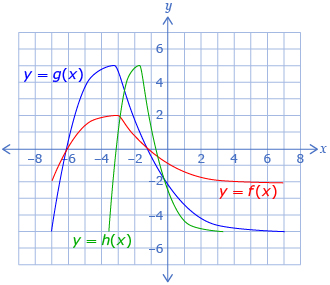As in previous lessons, the process of using an equation of the form y = af(bx) to graph a function can be reversed to determine the equation of a function given a graph.
Try This 3
Janila is working on her transformation project and has drawn an original function, y = f(x), and transformed the function to produce y = g(x) and y = h(x). Determine an equation to represent g(x) and h(x) in terms of f(x).

 Save your work in your course folder.
Save your work in your course folder.
“Example 4” on page 25 of the textbook shows an example of how the equation of a function can be determined from a graph. If you felt comfortable completing Try This 3, move on to Self-Check 4. If you want to see another example, read “Example 4.”
Self-Check 4
Complete questions 7 and C3 and revisit C2 on pages 29 and 31 of the textbook. Answer
Add the following terms to your copy of Glossary Terms:
Add the following formula to your copy of Formula Sheet:

![]() Save your work in your course folder.
Save your work in your course folder.